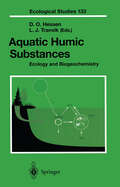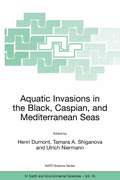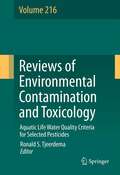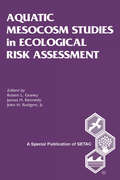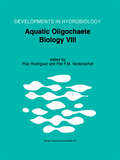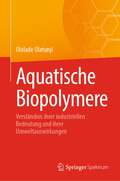- Table View
- List View
Aquatic Ecosystems in a Changing Climate
by Donat-P Häder Kunshan GaoGlobal climate change affects productivity and species composition of freshwater and marine aquatic ecosystems by raising temperatures, ocean acidification, excessive solar UV and visible radiation. Effects on bacterioplankton and viruses, phytoplankton and macroalgae have farreaching consequences for primary consumers such as zooplankton, invertebrates and vertebrates, as well as on human consumption of fish, crustaceans and mollusks. It has affected the habitation of the Arctic and Antarctic oceans the most so far. Increasing pollution from terrestrial runoff, industrial, municipal and household wastes as well as marine transportation and plastic debris also affect aquatic ecosystems.
Aquatic Ecosystems in a Changing Climate
by Donat-P Häder Kunshan GaoGlobal climate change affects productivity and species composition of freshwater and marine aquatic ecosystems by raising temperatures, ocean acidification, excessive solar UV and visible radiation. Effects on bacterioplankton and viruses, phytoplankton and macroalgae have farreaching consequences for primary consumers such as zooplankton, invertebrates and vertebrates, as well as on human consumption of fish, crustaceans and mollusks. It has affected the habitation of the Arctic and Antarctic oceans the most so far. Increasing pollution from terrestrial runoff, industrial, municipal and household wastes as well as marine transportation and plastic debris also affect aquatic ecosystems.
Aquatic Ecotoxicology: Understanding Pollutants, Aquatic Organisms, and their Environments
by Samreen Siddiqui Susanne M. BranderThis textbook offers a basic understanding of aquatic ecotoxicology from molecular to physiological levels for graduate and advanced undergraduate students. The book covers the guidelines and lab protocols used by international organizations for ecotoxicology studies, and discusses the challenges faced by aquatic organisms in a changing climate from an ecotoxicological perspective. Readers will learn about pollutants, contaminants and chemicals of emerging concern (CECs) in aquatic environments, their impacts on environmental and human health, and what techniques can be used to curb and control their adverse impacts. The book will be useful for students in aquatic ecotoxicology, environmental pollution and marine biochemistry.
Aquatic Environmental Systems – an Interdisciplinary Approach for Scientists and Engineers
by Roger C. Viadero, Jr.Considering that environmental science draws students and practitioners with widely varied backgrounds, there is a need for materials that help readers to grow their knowledge of fundamental principles from chemistry, physics, and biology to understand, describe, and predict the ways in which constituents (sediment, nutrients, organic matter, etc.) interact and move in aquatic systems (rivers, lakes, groundwater, and the atmosphere). Aquatic Environmental Systems: An Interdisciplinary Approach for Scientists and Engineers focuses on developing a common vocabulary and a rigorous material balance-based approach to understanding these movements and interactions. It examines the key properties of water and the ways they impact the behavior of water in the environment, providing a focused enumeration of those aspects of water structure that have direct and profound impacts on aquatic environmental systems. Features: Provides open-ended exercises to allow students to tailor work to their personal local/regional interests. Focuses on conveying understanding of the underlying principles and assumptions/limitations which are frequently underemphasized or overlooked entirely in other books. Deemphasizes straight memorization while focusing on methods that can be applied to more broad-based problem solving. Accommodates a wide range of mathematics skills and backgrounds.
Aquatic Environmental Systems – an Interdisciplinary Approach for Scientists and Engineers
by Roger C. Viadero, Jr.Considering that environmental science draws students and practitioners with widely varied backgrounds, there is a need for materials that help readers to grow their knowledge of fundamental principles from chemistry, physics, and biology to understand, describe, and predict the ways in which constituents (sediment, nutrients, organic matter, etc.) interact and move in aquatic systems (rivers, lakes, groundwater, and the atmosphere). Aquatic Environmental Systems: An Interdisciplinary Approach for Scientists and Engineers focuses on developing a common vocabulary and a rigorous material balance-based approach to understanding these movements and interactions. It examines the key properties of water and the ways they impact the behavior of water in the environment, providing a focused enumeration of those aspects of water structure that have direct and profound impacts on aquatic environmental systems. Features: Provides open-ended exercises to allow students to tailor work to their personal local/regional interests. Focuses on conveying understanding of the underlying principles and assumptions/limitations which are frequently underemphasized or overlooked entirely in other books. Deemphasizes straight memorization while focusing on methods that can be applied to more broad-based problem solving. Accommodates a wide range of mathematics skills and backgrounds.
Aquatic Food Quality and Safety Assesment Methods
by R. Jeya Shakila G. JeyasekaranThe book explains on the methods and procedures adopted for testing the quality and safety of aquatic food products. The analytical techniques available for testing the chemical constituents of aquatic food with separate chapters on the analysis of lipids, proteins, vitamins, and minerals are exhaustively given to determine their nutritional quality. The various methods for sensory, physical, biochemical and microbiological quality assessments of aquatic food are explicitly given with detailed protocols for easy adoption. Special chapters covering the chemical contaminants and permitted additives for residue monitoring are dealt, as they are important food safety requirements. This book will be very helpful for the food quality control technologists, food analysts, research scholars, and fisheries professionals as a holistic guide on a variety of testing procedures for facile adoption to meet the food safety and quality regulatory requirements. Note: T& F does not sell or distribute the Hardback in India, Pakistan, Nepal, Bhutan, Bangladesh and Sri Lanka.
Aquatic Food Quality and Safety Assesment Methods
by R. Jeya Shakila G. JeyasekaranThe book explains on the methods and procedures adopted for testing the quality and safety of aquatic food products. The analytical techniques available for testing the chemical constituents of aquatic food with separate chapters on the analysis of lipids, proteins, vitamins, and minerals are exhaustively given to determine their nutritional quality. The various methods for sensory, physical, biochemical and microbiological quality assessments of aquatic food are explicitly given with detailed protocols for easy adoption. Special chapters covering the chemical contaminants and permitted additives for residue monitoring are dealt, as they are important food safety requirements. This book will be very helpful for the food quality control technologists, food analysts, research scholars, and fisheries professionals as a holistic guide on a variety of testing procedures for facile adoption to meet the food safety and quality regulatory requirements. Note: T& F does not sell or distribute the Hardback in India, Pakistan, Nepal, Bhutan, Bangladesh and Sri Lanka.
Aquatic Humic Substances: Ecology and Biogeochemistry (Ecological Studies #133)
by Dag Hessen Lars J. TranvikHumic substances occur in all kinds of aquatic systems, but are particularly important in northern, coniferous areas. They strongly modify the aquatic ecosystems and also constitute a major problem in the drinking water supply.This volume covers all aspects of aquatic humic substances, from their origin and chemical properties, their effects on light and nutrient regimes and biogeochemical cycling, to their role regarding organisms, productivity and food web organization from bacteria to fish. Special emphasis is paid to carbon cycling and food web organization in humic lakes, but aspects of marine carbon cycling related to humus are treated as well.
Aquatic Invasions in the Black, Caspian, and Mediterranean Seas (Nato Science Series: IV: #35)
by Henri Dumont Tamara A. Shiganova Ulrich NiermannThe Mediterranean, Black, and Caspian Seas, the rivers and canals that connect them, and the enormous volume of shipping in the region, represent a conduit for aquatic invasion, whose consequences are only now beginning to be understood. This book provides an up-to-date overview of jelly invasions in the Ponto-Caspian which have affected local ecosystems since the early 1980s, contrasting that with other biological invasions, in search of underlying principles.
Aquatic Life Water Quality Criteria for Selected Pesticides (Reviews of Environmental Contamination and Toxicology #216)
by Ronald S. TjeerdemaReviews of Environmental Contamination and Toxicology attempts to provide concise, critical reviews of timely advances, philosophy and significant areas of accomplished or needed endeavor in the total field of xenobiotics, in any segment of the environment, as well as toxicological implications.
Aquatic Mesocosm Studies in Ecological Risk Assessment
by Robert L. GraneyA Special Publication of the Society of Environmental Toxicology and Chemistry (SETAC)Aquatic Mesocosm Studies in Ecological Risk Assessment discusses the methods currently used for conducting simulated field studies and provides a series of case histories in which mesocosm type studies have been used to assess the impact of pesticides on aquatic ecosystems. Specific chapters address the dosing and exposure components of such studies and how they influence experimental design. Advantages and disadvantages of various statistical designs are addressed in detail. Regulatory aspects of the design and interpretation of these studies are also covered. The book will be a superb reference for aquatic biologists, ecologists, toxicologists, environmental toxicologists, environmental chemists, and regulatory personnel.
Aquatic Mesocosm Studies in Ecological Risk Assessment
by Robert L. GraneyA Special Publication of the Society of Environmental Toxicology and Chemistry (SETAC)Aquatic Mesocosm Studies in Ecological Risk Assessment discusses the methods currently used for conducting simulated field studies and provides a series of case histories in which mesocosm type studies have been used to assess the impact of pesticides on aquatic ecosystems. Specific chapters address the dosing and exposure components of such studies and how they influence experimental design. Advantages and disadvantages of various statistical designs are addressed in detail. Regulatory aspects of the design and interpretation of these studies are also covered. The book will be a superb reference for aquatic biologists, ecologists, toxicologists, environmental toxicologists, environmental chemists, and regulatory personnel.
Aquatic Oligochaete Biology VIII: Proceedings of the 8th International Symposium on Aquati Oligochaeta, held in Bilbao, Spain, 18–22 July 2000 (Developments in Hydrobiology #158)
by Pilar Rodriguez Piet F. M. VerdonschotThis book contains 26 contributions dealing with the biology of aquatic oligochaetes and covers a wide range of topics including taxonomy, morphology, ultrastructure, embryology, reproduction, feeding biology, ecotoxicity, community studies, and species distribution. Descriptions of new taxa in tropical areas, including Amazonian forest soils, as well as overviews on the biodiversity of aquatic oligochaetes in Australia and European groundwaters, are presented. New morphological characteristics in both marine and freshwater species are described and interpreted. Laboratory studies contribute to the knowledge of oligochaete feeding biology and reproduction. The use of aquatic oligochaetes in ecological risk assessment is analysed in detail, and standardised experimental designs for studies on bioaccumulation and pollutant transfer by food are included. Finally, a number of papers present the effects of oliogochaetes on the performance of an activated sludge plant, and multivariate approaches to the spatial and/or temporal distribution and composition of oligochaete communities in many different areas of the world, from the scale of a river to the scale of the microhabitat. The broad scope of this volume is a reflection of recent rends, not only in oligochaete research, but also in general applied biological studies.
Aquatic Pollution: An Introductory Text
by Edward A. LawsSince the publication of the third edition of Aquatic Pollution in 2000, there have been many major developments within the field in terms of research, regulations, and also large-scale catastrophes that have had a significant impact on the aquatic environment; the Deepwater Horizon oil spill and the Fukushima nuclear disaster have taken their toll, and research on ocean acidification has developed enormously over the last decade. Recognizing, controlling, and mitigating aquatic pollution on a global scale is one of the most important and most difficult challenges facing society today.Fully updated to reflect current understanding and discussing these major recent developments, this fourth edition of Aquatic Pollution covers every aspect of pollution associated with urban runoff, acid rain, sewage disposal, pesticides, oil spills, nutrient loading, and more. Case studies of major pollution sites, all original to this new edition, help to illustrate points made in general discussion.Offering unprecedented depth of coverage, and discussing both fresh and sea water environments, this unique text provides a key teaching and learning tool for courses in environmental science, zoology, oceanography, biology, and civil or sanitary engineering, as well as a vital book for government policy makers. It is also an excellent primer for policymakers and activists focused on environmental issues.
Aquatic Pollution: An Introductory Text
by Edward A. LawsSince the publication of the third edition of Aquatic Pollution in 2000, there have been many major developments within the field in terms of research, regulations, and also large-scale catastrophes that have had a significant impact on the aquatic environment; the Deepwater Horizon oil spill and the Fukushima nuclear disaster have taken their toll, and research on ocean acidification has developed enormously over the last decade. Recognizing, controlling, and mitigating aquatic pollution on a global scale is one of the most important and most difficult challenges facing society today.Fully updated to reflect current understanding and discussing these major recent developments, this fourth edition of Aquatic Pollution covers every aspect of pollution associated with urban runoff, acid rain, sewage disposal, pesticides, oil spills, nutrient loading, and more. Case studies of major pollution sites, all original to this new edition, help to illustrate points made in general discussion.Offering unprecedented depth of coverage, and discussing both fresh and sea water environments, this unique text provides a key teaching and learning tool for courses in environmental science, zoology, oceanography, biology, and civil or sanitary engineering, as well as a vital book for government policy makers. It is also an excellent primer for policymakers and activists focused on environmental issues.
Aquatic Pollution: Concerns and Abatement
by Imtiyaz Qayoom Adnan Abubakr Anu Gopinath Shabir A. Dar Keezia KhurshidThis book discusses the sources, mechanism, impact and abatement of pollution in waterbodies and lays a base foundation for further research. In this book, readers will also get acquainted with the methods of decontamination of lakes by phytoremediation, pesticide removal techniques from lakes, toxic site reclamation and environmental sustainability using microbial aspects associated with clean-up of wastes.Based on the issues related to pollution of aquatic environments, the subject matter of this book includes: Nanoplastic Pollutants Affecting Fisheries Sector All Over the World Freshwater Floral Diversities as Pollution Indicators Radioactive Waste: Sources and Impact on Environment Environmental Sustainability Using Microbial Aspects Associated With Clearing Up Waste Nitrates and Phosphates: Boon or Bane for Waterbodies Print edition not for sale in South Asia (India, Sri Lanka, Nepal, Bangladesh, Pakistan and Bhutan)
Aquatic Pollution: Concerns and Abatement
by Imtiyaz Qayoom Adnan Abubakr Anu Gopinath Keezia Khurshid Shabir Ahmad DarThis book discusses the sources, mechanism, impact and abatement of pollution in waterbodies and lays a base foundation for further research. In this book, readers will also get acquainted with the methods of decontamination of lakes by phytoremediation, pesticide removal techniques from lakes, toxic site reclamation and environmental sustainability using microbial aspects associated with clean-up of wastes.Based on the issues related to pollution of aquatic environments, the subject matter of this book includes: Nanoplastic Pollutants Affecting Fisheries Sector All Over the World Freshwater Floral Diversities as Pollution Indicators Radioactive Waste: Sources and Impact on Environment Environmental Sustainability Using Microbial Aspects Associated With Clearing Up Waste Nitrates and Phosphates: Boon or Bane for Waterbodies Print edition not for sale in South Asia (India, Sri Lanka, Nepal, Bangladesh, Pakistan and Bhutan)
Aquatic Telemetry: Proceedings of the Fourth Conference on Fish Telemetry in Europe (Developments in Hydrobiology #165)
by Eva B. Thorstad, Ian A. Fleming and Tor Fredrik NæsjeThis volume provides a selection of the most significant papers presented at the Fourth Conference on Fish Telemetry in Europe, in Trondheim, Norway, in 2001. Papers are focused on migratory patterns and habitat utilisation, social behaviour, physiological ecology, fisheries management, effects of human impact on fish populations, aquaculture and methodology, and new technology. This book is aimed at scientists and engineers actively involved in aquatic telemetry projects, aquatic biologists (marine and freshwater), fisheries biologists and managers.
Aquatische Biopolymere: Verständnis ihrer industriellen Bedeutung und ihrer Umweltauswirkungen
by Ololade OlatunjiDieses Buch gibt einen umfassenden Überblick über die jüngsten Entwicklungen bei industriellen Anwendungen, Verarbeitungstechniken und Modifikationen von Polymeren aus marinen Quellen. Es führt den Leser systematisch in die Biomaterialien Chitin, Kollagen, Alginate, Cellulose und Polyester ein und stellt eine Verbindung zwischen ihrer industriellen Bedeutung und ihren Auswirkungen auf die Umwelt her. Das Buch verdeutlicht die Auswirkungen der industriellen Nutzung des aquatischen Systems für organische und anorganische Stoffe auf die Umwelt und vertieft das Verständnis der industriellen und wirtschaftlichen Bedeutung aquatischer Biopolymere. Darüber hinaus geht es um die Frage, wie die Erhaltung des aquatischen Lebens und das industrielle und wirtschaftliche Interesse an der Entwicklung biologisch abbaubarer Alternativen für Kunststoffe in Einklang gebracht werden können. Das Buch richtet sich daher an Wissenschaftler:innen aus den Bereichen Chemie, Material- und Polymerwissenschaften sowie Ingenieurwesen.
Aqueous Phase Adsorption: Theory, Simulations and Experiments
by Jayant K. Singh Nishith VermaThis book covers theoretical aspects of adsorption, followed by an introduction to molecular simulations and other numerical techniques that have become extremely useful as an engineering tool in recent times to understand the interplay of different mechanistic steps of adsorption. Further, the book provides brief experimental methodologies to use, test, and evaluate different types of adsorbents for water pollutants. Through different chapters contributed by accomplished researchers working in the broad area of adsorption, this book provides the necessary fundamental background required for an academician, industrial scientist or engineer to initiate studies in this area. Key Features Explores fundamentals of adsorption-based separation Provides physical insight into aqueous phase adsorption Includes theory, molecular and mesoscopic level simulation techniques and experiments Describes molecular simulations and lattice-Boltzmann method based models for aqueous phase adsorption Presents state-of-art experimental works particularly addressing removal of "emerging pollutants" from aqueous phase
Aqueous Phase Adsorption: Theory, Simulations and Experiments
by Jayant K. Singh Nishith VermaThis book covers theoretical aspects of adsorption, followed by an introduction to molecular simulations and other numerical techniques that have become extremely useful as an engineering tool in recent times to understand the interplay of different mechanistic steps of adsorption. Further, the book provides brief experimental methodologies to use, test, and evaluate different types of adsorbents for water pollutants. Through different chapters contributed by accomplished researchers working in the broad area of adsorption, this book provides the necessary fundamental background required for an academician, industrial scientist or engineer to initiate studies in this area. Key Features Explores fundamentals of adsorption-based separation Provides physical insight into aqueous phase adsorption Includes theory, molecular and mesoscopic level simulation techniques and experiments Describes molecular simulations and lattice-Boltzmann method based models for aqueous phase adsorption Presents state-of-art experimental works particularly addressing removal of "emerging pollutants" from aqueous phase
Aqueous Polymer — Cosolute Systems: Special Issue in Honor of Dr. Shuji Saito (Progress in Colloid and Polymer Science #122)
by Dan F. AnghelAqueous Polymeric Coatings for Pharmaceutical Dosage Forms (Drugs and the Pharmaceutical Sciences)
by Linda A. FeltonAqueous-based film coating has become routine in the pharmaceutical industry. This process eliminates the use of organic solvents and thus avoids economic, environmental, and toxicological issues related to residual solvents and solvent recovery. Aqueous-based coating, however, is complex and many variables may impact the final product and its performance. This fourth edition of Aqueous Polymeric Coatings for Pharmaceutical Dosage Forms aims to provide insight into the factors and parameters that should be considered and controlled for the successful development and commercialization of a coated product. The fourth edition has been revised and expanded to reflect the most recent scientific advancements from the literature. The contributing authors explain in detail, using illustrated examples, appropriate steps to solve and ideally avoid formulation, processing, and stability problems and to achieve an optimized dosage form. Trade names and chemical names of commercially marketed coatings are used throughout the text to help familiarize the reader with the various materials available for pharmaceutical applications. This book will be a valuable resource for anyone in the pharmaceutical industry working in the area of aqueous-based film coating.
Aqueous Polymeric Coatings for Pharmaceutical Dosage Forms (Drugs and the Pharmaceutical Sciences)
by Linda A. FeltonAqueous-based film coating has become routine in the pharmaceutical industry. This process eliminates the use of organic solvents and thus avoids economic, environmental, and toxicological issues related to residual solvents and solvent recovery. Aqueous-based coating, however, is complex and many variables may impact the final product and its performance. This fourth edition of Aqueous Polymeric Coatings for Pharmaceutical Dosage Forms aims to provide insight into the factors and parameters that should be considered and controlled for the successful development and commercialization of a coated product. The fourth edition has been revised and expanded to reflect the most recent scientific advancements from the literature. The contributing authors explain in detail, using illustrated examples, appropriate steps to solve and ideally avoid formulation, processing, and stability problems and to achieve an optimized dosage form. Trade names and chemical names of commercially marketed coatings are used throughout the text to help familiarize the reader with the various materials available for pharmaceutical applications. This book will be a valuable resource for anyone in the pharmaceutical industry working in the area of aqueous-based film coating.
Aqueous Two-Phase Systems for Bioprocess Development for the Recovery of Biological Products (Food Engineering Series)
by Marco Rito-Palomares Jorge BenavidesThis comprehensive and unique text presents a full overview of downstream processing useful for those new to the concept as well as professionals with experience in the area. The history and theoretical principles of Aqueous Two-Phase Systems (ATPS) are covered in depth. Information on ATPS characterization and application is included, and ATPS equilibria and system parameters that have significant effect on partition behavior are studied. Aqueous Two-Phase Systems for Bioprocess Development for the Recovery of Biological Products addresses specific applications of ATPS for the recovery and partial purification of high molecular weight compounds such as proteins, nucleic acids and polysaccharides, particulate bioproducts such as cells and organelles and low molecular weight compounds. Non-conventional strategies involving ATPS such as affinity systems, continuous liquid-liquid fractionation stages and the recovery from plant extracts are presented. Economic analysis of the application of ATPS in comparison to other fractionation techniques, particularly liquid chromatography, is considered, as are opportunity and current trends in the ATPS research area. Each chapter utilizes the contributors' experimental expertise in traditional and non-conventional ATPS strategies, as well as analysis of areas of opportunity and perspectives on the development and future applications of ATPS in both the lab and larger scale operations. The result is a thorough and singular overview of ATPS which has not been matched by any other text on the market.




